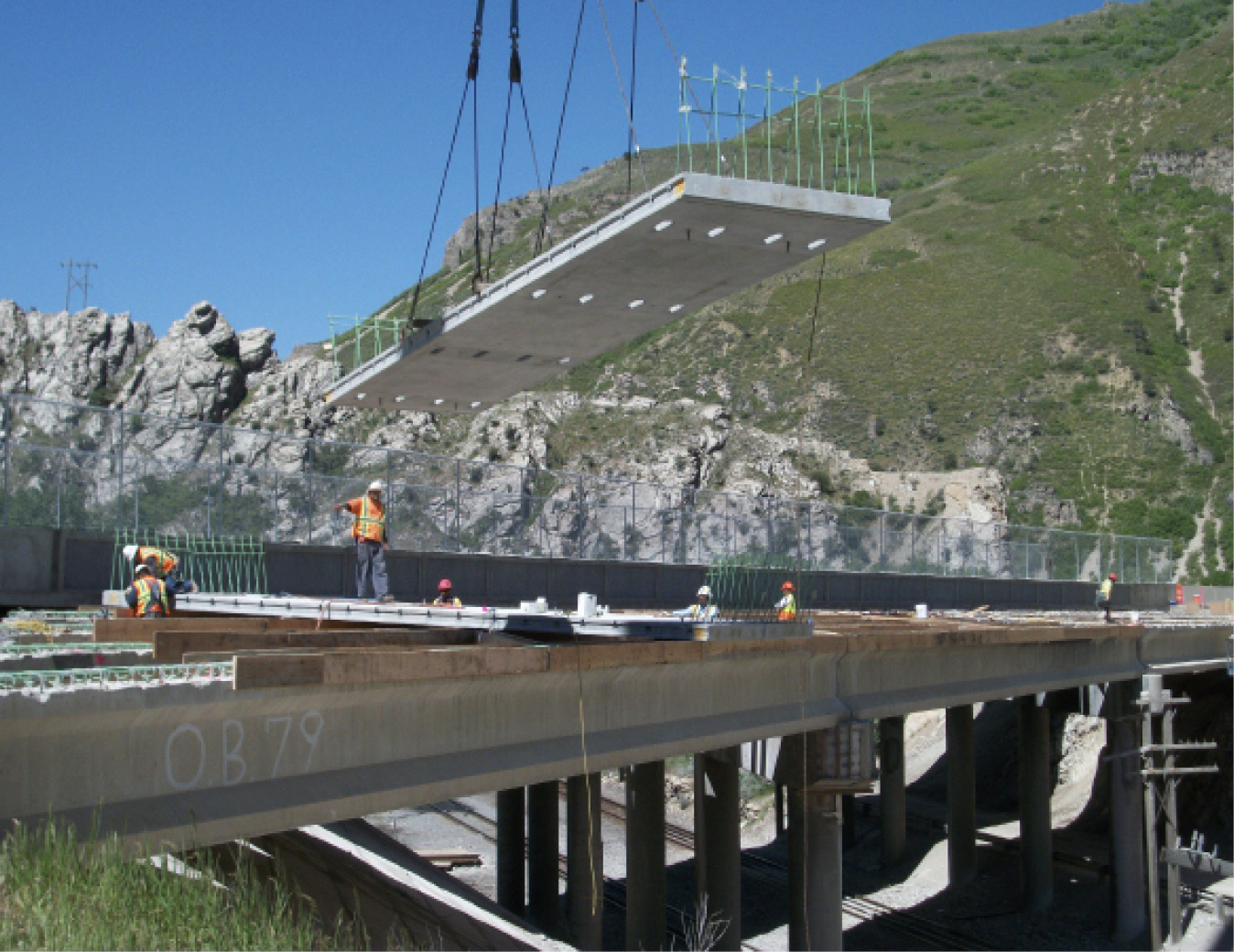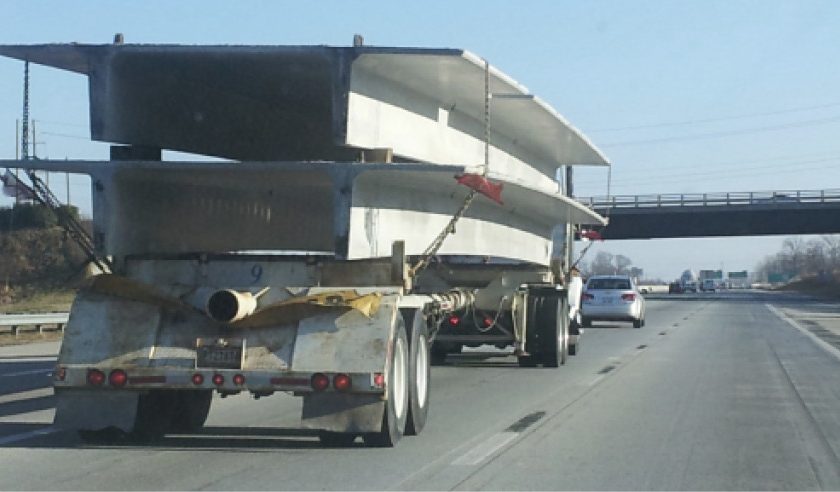Since the 1950s, the construction industry in the United States has reaped the benefits of using precast, prestressed concrete. These products increase installation efficiencies, provide ideal curing conditions for better concrete, and standardize measurements through mass production. However, because precast, prestressed concrete must be shipped to the jobsite, it can contribute to higher transportation costs. In addition, it comes with limitations that can cause jobsite delays and increase the embodied carbon footprint of a project.
Precast, prestressed concrete made from expanded shale, clay or slate (ESCS) structural lightweight aggregates (ASTM C330) can be made up to 35 percent lighter while increasing its durability and resiliency to reduce the limitations of conventional concrete bridge elements—from girders and seats to wingwalls and piles. Lighter concrete structures translate to minimized dead loads, less overall material used because elements can be made thinner, reduced seismic inertia, improved energy performance, and increased service life. It also means projects can be completed with smaller rated cranes and fewer truckloads to ease installation requirements. These benefits also help projects lower their carbon footprint without sacrificing short- or long-term performance. This eases scheduling requirements and improves bottom lines. Furthermore, ESCS structural lightweight aggregates contribute to internal curing (ASTM C1761), which leads to stronger, more resilient concrete.

Both reduced weight and increased durability can benefit multiple aspects of concrete construction, resulting in increased energy performance and service life that more readily satisfy construction professionals, project owners and end-users. Therefore, precast and prestressed concrete producers can maximize the quality of elements they provide while exceeding expectations of customers who seek a “greener” and more sustainable project by using ESCS structural lightweight aggregates. The following will detail both how these aggregates help projects that use precast, prestressed concrete products be more efficient and how their ability to increase resilience leads to more sustainable construction.
STRUCTURAL LIGHTWEIGHT CONCRETE PRODUCTION
To fully understand how structural lightweight concrete creates better and more sustainable bridges, it is necessary to know its DNA. Many, if not all, of its benefits are derived from its components, specifically ESCS structural lightweight aggregates.
Building on a history that extends into antiquity, ESCS structural lightweight aggregates have had successful widespread use for the past 95 years. The ceramic lightweight aggregate is prepared by expanding select minerals (clay, shale and slate) in a rotary kiln at temperatures over 2,000°F. This production and raw material selection process is strictly controlled to ensure a uniform network of nonconnected voids. It also produces an aggregate that is structurally strong, stable, durable and inert. Lightweight concrete made with ESCS aggregates has strengths comparable to normal weight concrete yet is typically 25 percent to 35 percent lighter.
To take full advantage of ESCS aggregates, concrete producers should precondition (saturate) them in water for three to seven days prior to adding to the concrete mix. This allows the moisture content within the particles to reach the 70 to 80 percent thresholds needed for internal curing. Once the aggregate has been soaked and added to the mix, it can be poured or placed like conventional concrete.
Although lightweight concrete made from ESCS requires different processes and resources, it significantly improves the quality of concrete while optimizing structural efficiency. Improved quality and optimized structural efficiency can reduce material requirements across the entire project, offsetting the product’s initial higher costs—both economically and environmentally.
Although lightweight concrete made from ESCS requires different processes and resources, it significantly improves the quality of concrete while optimizing structural efficiency. Improved quality and optimized structural efficiency can reduce material requirements across the entire project, offsetting the product’s initial higher costs—both economically and environmentally.
REDUCED WEIGHT LEADS TO EFFICIENT SHIPPING AND INSTALLATION
Because ESCS structural lightweight concrete is less dense, prestressed girders and other precast elements can be made larger while still fitting within truck load limits. This can help reduce the number of shipments required to complete a project, saving fuel and diminishing embodied emissions that would otherwise be necessary for transit. It can also sideline scheduling issues and unforeseen delays to help bridge construction more easily stay on schedule.
In “A Holistic Approach to Sustainability for the Concrete Community,” two projects by (pre-Arcosa Lightweight) Big River Industries are analyzed to determine the differences in projected shipping costs between normal weight and lightweight concrete products. In the first project, the number of truckloads of precast concrete was reduced from 431 to 287 and from 87 to 66 in the second, as more elements could be loaded on each truck due to the lowered density. By needing fewer truckloads, these projects spent less on transportation costs and generated fewer carbon emissions.
However, the improvements to shipping costs are not the only way ESCS structural lightweight aggregates benefit construction. Because structural lightweight concrete is less dense than conventional concrete, it can be placed with a smaller rated crane. This can widen the options of onsite equipment to streamline installation. Less dense concrete can also provide larger but still easily shippable bridge elements. These larger products also contribute to more efficient installation by reducing the number of parts to be placed.
For example, the southbound Interstate 5 Puyallup River Bridge near Tacoma, Wash. used precast lightweight concrete to increase the length of the bridge girders to an unheard of 223 feet and 4.5 inches, which bests conventional girder lengths by more than 13 feet. The record-breaking size allowed the construction crews to work around tight schedules caused by a railway directly below a portion of the bridge, which would require crews to pause whenever a freight train passed underneath. Streamlining this aspect of construction helped ensure the project was completed with as few labor hours and profits lost to these pauses as possible.
For precast, prestressed concrete producers, being able to meet common and extraordinary jobsite constraints can help provide more value to customers, improving company reputation and the possibility of repeat business. Structural lightweight concrete, because it leads to efficient shipping and installation, can more effectively meet a larger range of construction needs than normal weight concrete.
INTERNAL CURING INCREASES DURABILITY
Precast concrete must be strong, durable and resilient to create long-term sustainable structures. While strength and durability depend on multiple factors, permeability and cracking are arguably the predominant causes of concern. Industry professionals can reduce corrosion and mitigate premature concrete shrinkage and cracking damage by using ESCS structural lightweight aggregates for internal curing.
Highly permeable concrete allows harmful chemicals to pass through it, which can lead to the corrosion of steel rebar. This weakens the structural integrity of the concrete and is an especially poignant concern for structures near salt water or where deicing chemicals are used, since they can cause damage more quickly due to chloride attack. Likewise, cracking can also lead to rebar corrosion and the erosion of the concrete itself.
Because lightweight concrete cures from the inside out, the bond strength between the aggregate particles and the cement paste increases for reduced permeability. As reported in a 2008 paper presented at the Concrete Bridge Conference, the permeability of sand lightweight concrete was measured for 17 different batches for a long highway bridge deck. The average permeability for all batches of the lightweight concrete was 989 coulombs—well below the 2,500-coulomb limit in the specifications.
Since ESCS structural lightweight aggregate provides a greater bond at the interface between two porous materials (aggregate particles and hydrating cementitious paste), it has a reduced modulus of elasticity and coefficient of thermal expansion as well as lower shrinkage rates. This greatly reduces the potential for cracking over conventional concrete. As such, the material resists freeze-thaw damage and is vital for cold climate bridges, since deicers contribute to rapid freeze-thaw cycles and chloride attack.
ESCS structural lightweight aggregates can contribute to more durable precast concrete by defending against permeability and cracking. This creates resilient infrastructure assets that will require fewer patches and repairs over their service life, which both costs less for project owners to maintain and mitigates the embodied energy of a project over time. For precast and prestressed concrete producers, citing these long-term benefits can give those who use ESCS structural lightweight aggregates an upper hand in bidding and negotiating contracts.
CROSSING THE BRIDGE
Structural lightweight concrete made from ESCS aggregates can amplify the benefits of using precast elements in construction. While these advantages can be readily seen in bridge construction, they can also be applicable in other areas where precast concrete is used.
Professionals who use this type of structural lightweight concrete can expect reduced shipping requirements and costs. They can also anticipate their projects to have less embodied emissions. Further, because precast lightweight concrete aids in efficient installation, professionals can significantly cut wastes caused by down time.
Project owners can expect resilient structures that withstand wear and tear for much longer than conventional concrete—indicating a greater return on investment and a more environmentally conscious project. These expectations can extend from bridgework to low- and mid-rise buildings, hotels, waste water and stormwater management and other heavy/civil applications. With ESCS structural lightweight aggregates, we do have the technology, we can build better, stronger and lighter than ever before.
Darren Medeiros is a Regional Technical Salesperson at Holcim Lightweight Aggregates – Utelite Plant. He has two decades of experience working in the lightweight aggregate industry. He is active in several Expanded Shale, Clay and Slate Institute (ESCSI) committees involving the use of lightweight concrete.


